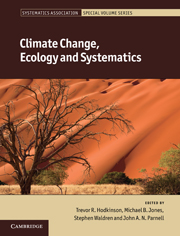Book contents
- Frontmatter
- Contents
- List of contributors
- Preface
- Section 1 Introduction
- Section 2 Adaptation, speciation and extinction
- 4 Global climate and extinction: evidence from the fossil record
- 5 Long-term fluctuations in atmospheric CO2 concentration influence plant speciation rates
- 6 Wood anatomy and climate change
- 7 Savanna biome evolution, climate change and the ecological expansion of C4 grasses
- 8 Climate warming results in phenotypic and evolutionary changes in spring events: a mini-review
- 9 Terrestrial green algae: systematics, biogeography and expected responses to climate change
- Section 3 Biogeography, migration and ecological niche modelling
- Section 4 Conservation
- Index
- Systematics Association Publications
- Plate section
- References
4 - Global climate and extinction: evidence from the fossil record
from Section 2 - Adaptation, speciation and extinction
Published online by Cambridge University Press: 16 May 2011
- Frontmatter
- Contents
- List of contributors
- Preface
- Section 1 Introduction
- Section 2 Adaptation, speciation and extinction
- 4 Global climate and extinction: evidence from the fossil record
- 5 Long-term fluctuations in atmospheric CO2 concentration influence plant speciation rates
- 6 Wood anatomy and climate change
- 7 Savanna biome evolution, climate change and the ecological expansion of C4 grasses
- 8 Climate warming results in phenotypic and evolutionary changes in spring events: a mini-review
- 9 Terrestrial green algae: systematics, biogeography and expected responses to climate change
- Section 3 Biogeography, migration and ecological niche modelling
- Section 4 Conservation
- Index
- Systematics Association Publications
- Plate section
- References
Summary
Abstract
The Intergovernmental Panel on Climate Change (IPCC) has acknowledged that climate change represents a tangible threat to species richness, based largely on the evidence from climate envelope modelling and the shifts in ranges of current species. However, because of uncertainty in the accuracy of extinction forecasts from climate envelope modelling, it would be useful to have an alternative source of information. The evidence from the fossil record is less widely discussed, but supports the view that a warmer global climate will increase extinction rates even without other associated human impacts such as habitat loss. Fine-scale studies show heterogeneity in results, but global-scale analyses demonstrate that extinction rates are generally elevated during greenhouse phases and that biodiversity is depressed. These trends are consistent with studies of extinction events that have implicated global warming as a consistent cause, triggered by carbon dioxide (CO2) release from large igneous province eruptions. They suggest that abiotic factors such as climate are a major influence on biodiversity through time, but relatively predictably so (unlike the paradigm of the Court Jester). They indicate that there are perils of a warm climate distinct from those of climate change alone; that global biodiversity loss through climate change will only be reversed on geologic timescales; and that any reduction in global warming will bring some benefit to global biodiversity.
Introduction
What will be the consequences of anthropogenic climate change during the current and next centuries? This question dominates much of the current research in the biological and earth sciences.
- Type
- Chapter
- Information
- Climate Change, Ecology and Systematics , pp. 99 - 121Publisher: Cambridge University PressPrint publication year: 2011
References
- 3
- Cited by

